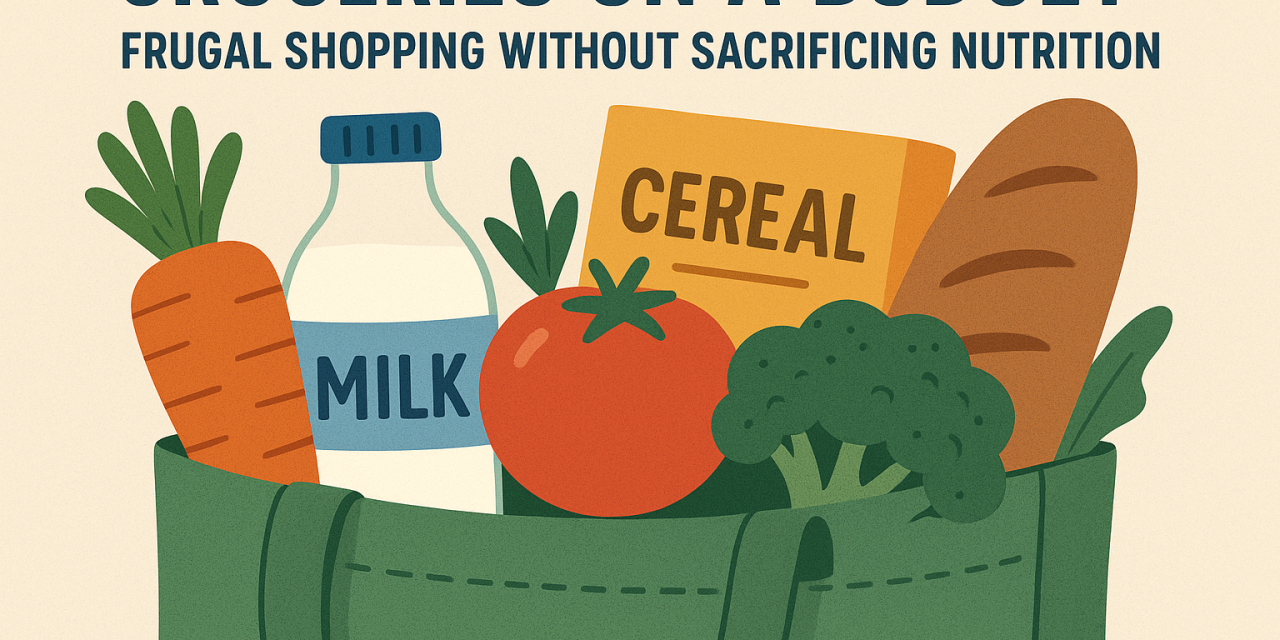Groceries on a Budget: Frugal Shopping Without Sacrificing Nutrition
Learn how to plan, shop, and cook so your money goes further while your plate stays colorful, balanced, and satisfying.
The goal: more nutrients per dollar
Eating well on a tight budget isn’t about restriction—it’s about strategy. Focus on:
- Nutrient density: Foods that deliver vitamins, minerals, fiber, and protein for the cost (beans, oats, eggs, frozen vegetables, canned fish).
- Satiety per dollar: Protein + fiber + healthy fats keep you full and reduce snacking.
- Versatility: Ingredients you can repurpose all week (rice, tortillas, yogurt, carrots, cabbage, leafy greens).
- Shelf life: Mix fresh with frozen and canned to avoid waste.
Step 1: Plan before you shop
- Take inventory: Check pantry, fridge, and freezer. Build meals around what you already have.
- Use a simple weekly framework: For example, “Soup Monday, Stir‑Fry Tuesday, Pasta Wednesday, Sheet‑Pan Thursday, Leftovers Friday, One‑Pot Saturday, Breakfast‑for‑Dinner Sunday.”
- Pick 8–10 core items on sale and pair with staples you maintain monthly (rice, oats, beans, canned tomatoes, oil, spices).
- Write a list by store section and stick to it. Shop after eating to avoid impulse buys.
Budget-friendly staples to keep on hand
- Whole grains: brown rice, oats, whole‑wheat pasta, tortillas.
- Beans & legumes: dry or canned beans, lentils, chickpeas; peanut or other nut butter.
- Protein: eggs, canned tuna/salmon, tofu/tempeh, chicken thighs, Greek yogurt.
- Produce: onions, carrots, cabbage, potatoes, bananas, apples, seasonal greens, frozen mixed vegetables.
- Flavor builders: canned tomatoes, tomato paste, soy sauce, vinegars, garlic, ginger, lemon/lime, basic spices (salt, pepper, cumin, chili, paprika, Italian blend).
- Fats: olive/neutral oil; butter or ghee (optional).
Step 2: Shop smart in the store
- Seasonal and “last‑chance” bins: Great for produce deals. Cook or freeze same‑day.
- Buy whole: Whole carrots, head cabbage, whole chicken or bone‑in cuts usually cost less than pre‑cut or boneless.
- Bulk bins: Purchase only what you need of spices, rice, oats, or nuts.
- Store brands: Start with generics for oats, beans, rice, dairy, and frozen veg.
- Avoid pricey “health halos”: Fancy packaging doesn’t always mean better nutrition. Read labels.
Quick label check: 30 seconds to better choices
- Ingredients list: Aim for short lists; watch for added sugars near the top.
- Protein & fiber: Prefer cereals/breads with ≥3g fiber and ≥5g protein per serving.
- Sodium & sugar: Choose low‑sodium canned goods and entrées with ≤10% DV sodium per serving; added sugars ideally ≤5–8g in breakfast items.
Produce that reliably fits tight budgets
These are usually affordable year‑round in the U.S. and offer excellent nutrition:
- Greens: kale, collards, spinach (fresh or frozen).
- Hearty veg: carrots, cabbage, onions, potatoes, sweet potatoes, beets.
- Fruit: bananas, apples, oranges; frozen berries for smoothies/oatmeal.
High‑value protein picks
- Dry lentils/beans: Cheap, shelf‑stable, and cook quickly (lentils ~20–30 minutes).
- Eggs: Versatile for any meal—scrambles, frittatas, fried rice, sandwiches.
- Canned fish: Tuna or salmon add protein, omega‑3s, and convenience.
- Tofu/tempeh: Excellent value plant protein; press tofu for better texture.
- Chicken thighs or drumsticks: Often the best price for meat; use bones for stock.
- Greek yogurt: Doubles as breakfast, sauce base, or snack.
Sample one‑week budget plan (flexible)
This template prioritizes repeatable building blocks to limit waste. Adjust quantities for your household and local prices.
| Day | Breakfast | Lunch | Dinner |
|---|---|---|---|
| Mon | Overnight oats with banana and peanut butter | Lentil & vegetable soup + toast | Chicken thigh sheet‑pan (carrots, onions, potatoes) |
| Tue | Eggs + sautéed greens + toast | Tuna white‑bean salad wrap | Veggie stir‑fry with tofu over rice |
| Wed | Yogurt, oats, and frozen berries | Leftover stir‑fry bowl | Chickpea tomato curry + rice |
| Thu | Oatmeal with apples and cinnamon | Soup + grilled cheese | Whole‑wheat pasta with garlicky greens & beans |
| Fri | Egg‑and‑veggie breakfast burrito | Curried chickpea salad on cabbage slaw | Frittata with potatoes, onions, and spinach |
| Sat | Pancakes or oats + fruit | Leftovers bowl | Rice + roasted veggies + yogurt herb sauce |
| Sun | Yogurt parfait | Tuna pasta salad | Bean & veggie chili; freeze extra portions |
Tip: Cook double rice, beans, and roasted vegetables early in the week to save time and energy.
Grocery list for the week (edit by sales and preferences)
- Grains: 2 lb brown rice; 1 lb whole‑wheat pasta; rolled oats; tortillas or sandwich bread.
- Protein: 1 dozen eggs; 1–2 lb chicken thighs; 1 block tofu; 2 cans beans; 1 lb dry lentils; 2 cans tuna or salmon; Greek yogurt.
- Vegetables: onions, carrots, potatoes/sweet potatoes, cabbage or leafy greens, garlic, 2 lemons/limes, 1–2 bags frozen mixed vegetables.
- Fruit: bananas, apples or seasonal fruit; 1 bag frozen berries.
- Pantry: canned tomatoes, tomato paste, peanut butter, oil, soy sauce, vinegar, basic spices, broth or bouillon (low‑sodium).
10 budget meals (about $0.75–$2.25 per serving, depending on local prices)
- Lentil & Veg Soup: Sauté onion, carrot, garlic. Add lentils, canned tomatoes, water/broth, spices. Simmer 25 minutes. Add greens at the end.
- Chickpea Tomato Curry: Sauté onion + spices, stir in chickpeas + tomatoes + a splash of coconut milk or yogurt. Serve over rice.
- Egg Fried Rice: Use leftover rice, frozen vegetables, scrambled eggs, soy sauce, and sesame oil (optional).
- Tuna White‑Bean Salad: Tuna + cannellini beans + lemon + olive oil + onion + herbs. Eat in a wrap or on greens.
- Tofu Stir‑Fry: Press tofu, pan‑sear, add mixed vegetables and sauce (soy, ginger, garlic, vinegar, a little sugar). Serve with rice.
- Sheet‑Pan Chicken: Thighs with potatoes, carrots, onions. Season well; roast 35–45 minutes at 425°F (220°C).
- Whole‑Wheat Pasta & Greens: Sauté garlic, add chopped greens and white beans; toss with pasta and a splash of pasta water.
- Breakfast Burritos: Eggs + beans + sautéed peppers/onions wrapped in tortillas. Freeze extras.
- Bean & Veg Chili: Beans, tomatoes, onion, peppers/carrots, chili spices. Simmer and portion for freezer.
- Yogurt Bowls: Greek yogurt with oats/ granola, frozen berries, and peanut butter drizzle.
Waste less, save more
- Prep once: Wash and chop hardy vegetables after shopping; store in clear containers so you see them.
- Freeze smart: Portion cooked beans, rice, soup, and chili into flat freezer bags or containers. Label with the date.
- Use scraps: Keep onion/garlic/carrot/celery ends in a freezer bag. When full, simmer for vegetable stock.
- FIFO rule: “First in, first out.” Rotate older items to the front of the fridge/pantry.
Adapting for special diets
- Vegetarian/Vegan: Rely on beans, lentils, tofu/tempeh, peanut butter; use fortified plant milks for calcium and vitamin D.
- Gluten‑free: Choose rice, corn tortillas, GF oats, and potatoes as starches; check labels on sauces.
- Low‑sodium: Use no‑salt‑added canned goods; season with acids (lemon, vinegar), garlic, and herbs.
- High‑protein focus: Greek yogurt, eggs, canned fish, tofu, chicken thighs, and bean‑grain combos (rice + beans) keep costs down.
Checkout checklist
- Did you shop your pantry and plan around sales?
- Did you compare unit prices and choose generics where quality is equal?
- Do your meals combine protein + fiber + produce for fullness and balance?
- Do you have a cook‑once, eat‑twice plan for grains, beans, and roasted vegetables?
- Did you set aside time to portion, label, and freeze extras?





